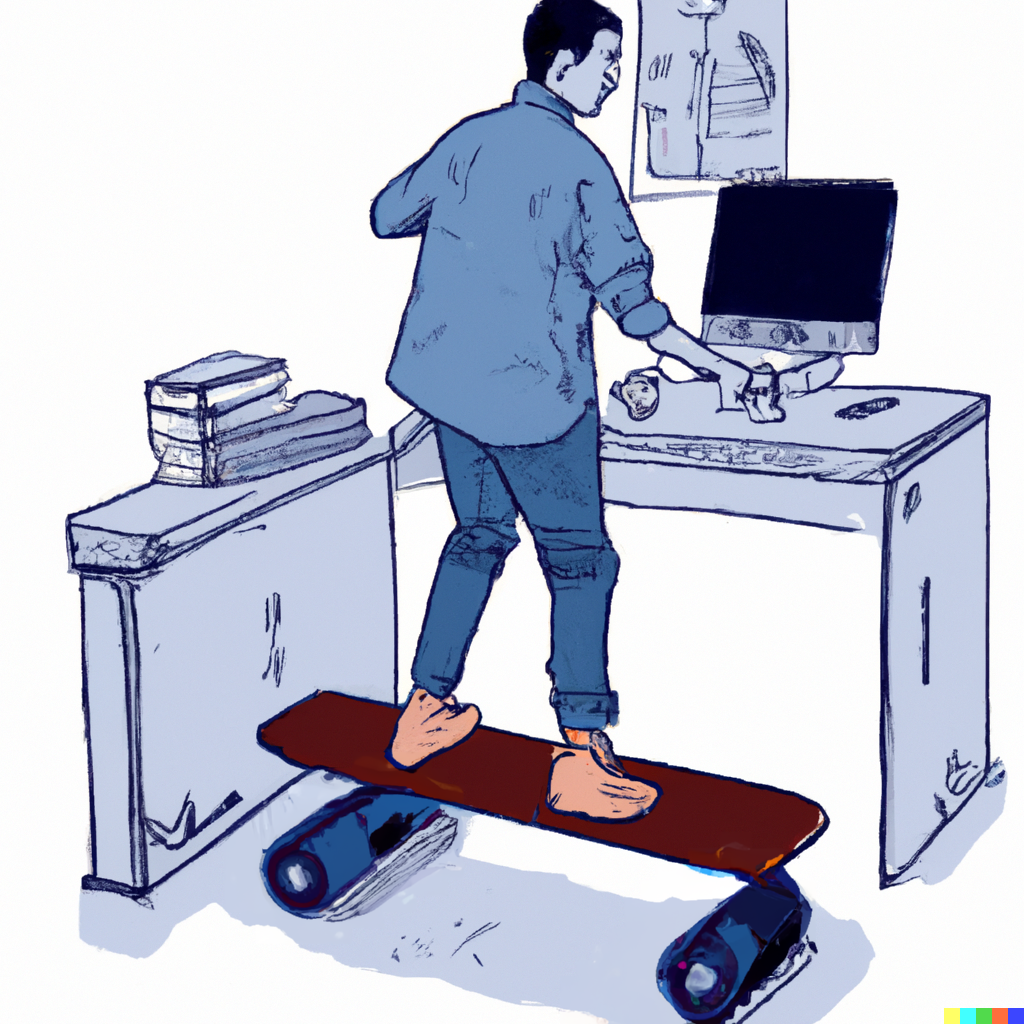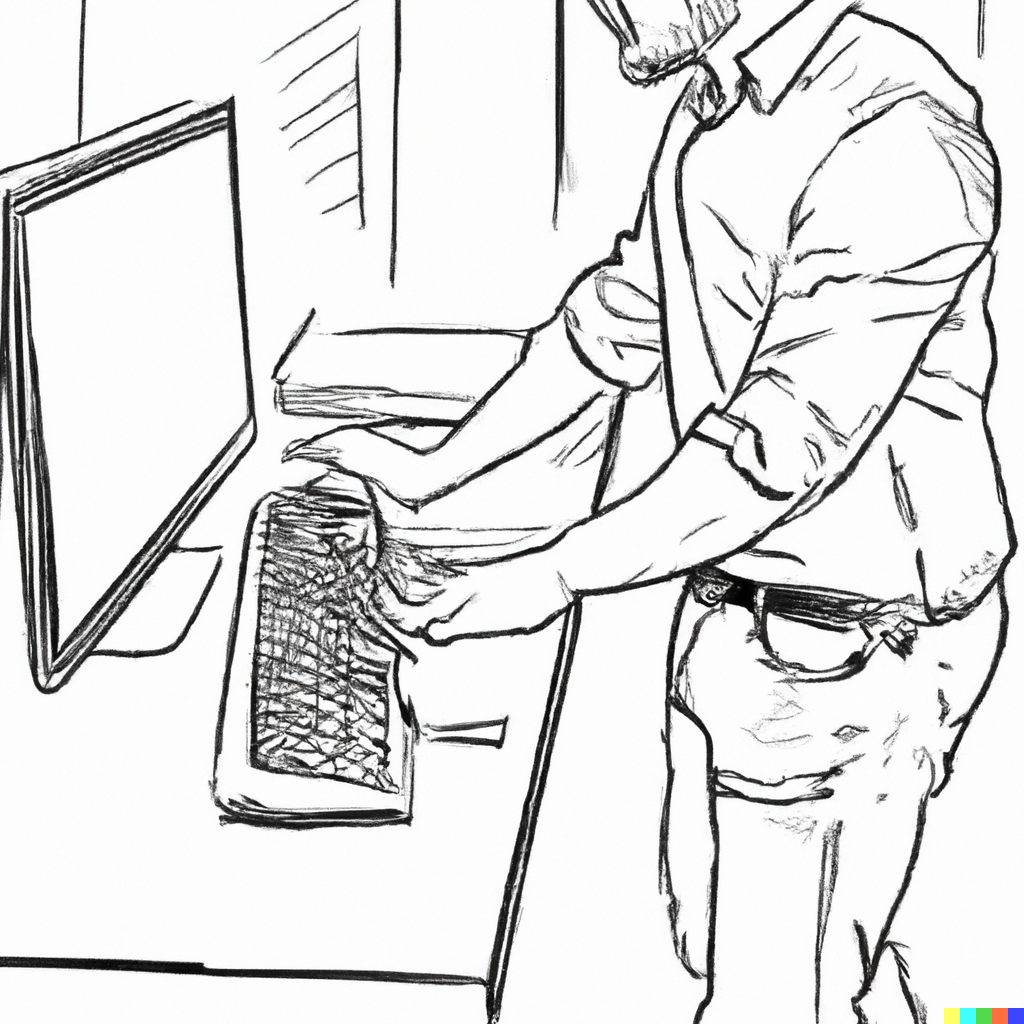Updates on my standing experiment: surprisingly good for the lower back
What’s working well
Although I initially liked the treadmill desk, I’ve become more fond of the double-roller balance board. I explained how I built this in Building your own balance board for a standing desk. By double-roller, I mean I’m using two 4” PVC pipes instead of one under the balance board. Admittedly, it makes it less of a balance board and more of a back-and-forth slider. However, the additional stability makes working on it more practical. There’s less pressure on my feet, and I can remain standing for a longer period of time.

The double roller addresses the biggest challenging of the standing desk: how to defeat standing fatigue. I’ve also tried several anti-fatigue mats, but the problem with standing for extended periods of time is the lack of movement. Contrast the stationary mat with something like the Movemate Active Standing Board ($359). Notice how with the Active Standing Board, your legs and feet are moving, simulating more of a walking motion? That’s the trick to being able to stand for longer periods of time without fatigue (at least for me). I haven’t tried the Active Standing Board (because it seems kinda pricey), but I’ve incorporated the idea of small movements.
When I first started using a balance board at work, I brought in my Revbalance 101 v2 board and tried not to move around too much—I didn’t want to make my colleague nervous about possibly falling on him, nor did I want to draw too much attention to myself by moving around in the office. However, with reduced movement in my legs and feet, I noticed that my feet, after a while, started to go numb. After 20 minutes or so, I was ready to switch back to a sitting position. It didn’t help that the floor was carpet, which made the roller much less rolly.
However, when I started using my double-roller with the larger board (sized to match the Revbalance Swell), with a particle board wood base as the floor, I had a lot more movement. More side-to-side hip and leg movement, and it simulated walking a lot more. My feet didn’t become numb. I could remain on the double-roller board for 45+ minutes without too much fatigue.
Additionally, when I added music, I found myself naturally moving a bit to the music’s rhythm and beat. Music naturally induced more of a natural walking/dancing motion with my legs, giving me more activity—all while remaining more or less stable so that I could actually do writing work while standing.
The double-roller balance board with music has become my favorite standing setup, so much so that I’ve minimized the treadmill (sadly). As a result, my study now has the cliché of an unused treadmill gathering dust in the middle of it. I plan to reincorporate the treadmill soon, though.
Challenges
My standing experiment is not without challenges. First, as I wrote about in my covid experience, when I got sick, I didn’t do any standing. But I also noticed another problem: ankle stress. Playing basketball, I’ve twisted my right ankle more times than I can count. Too much standing on balance boards (especially the single roller) puts a lot of stress on that ankle. I now feel my nerves sort of strained if I rotate my right ankle inward at a sharp angle. It’s weird, but I think it’s a version of Tarsal Tunnel syndrome thing where ankle swelling is impacting a nerve. This only happens in my right ankle, and is probably only a problem someone with an injured ankle might experience. I started wearing an ankle brace to address the problem. The nerve pain has mostly gone away.
The second challenge is getting the angle of the hands on the keyboard right. When I sit in a chair, my arms extend at a flat angle, such that my forearm meets my wrist at about 0 degrees. When I stand, there’s more of a bend between the forearm and wrist, creating a positive 15 degree angle or so (a slight “V”).
I fear that prolonged typing in this position might lead to carpal tunnel or something else harmful. I’m still experimenting with positions and assistive devices (like negative keyboard tilts), so I hope to figure out the right angle soon. In the meantime, I placed a three-ring binder upside down to create an angle. I’ve heard of other people using doorknobs to get the right negative angle on the keyboard.

My back
The biggest surprise about standing is the way my back feels: it feels a lot better. I didn’t realize that sitting for prolonged periods placed so much pressure on my back. Standing up periodically is like a revelation. If I switch to sitting again, after a while I can start to sense that mounting pressure on my back again. This lower back pain, especially from sitting, might be inherent to someone with a bulged disk.
I recently had an MRI on my lower back and the report showed that for my L3-L4 space, there was “small left greater than right paracentral/foraminal disk protrusions deforming the ventral thecal sac. Mild left foraminal narrowing without right foraminal narrowing.” In other words, there were small disc protrusions on the left side, causing minor narrowing of the space where nerves exit the spine on the left side. There are no issues on the right side. I believe many people have similar disc bulges, though, and might not even be aware of them. I actually got the MRI because I wondered if my recurring calf strains might be connected to some issue in my lower back. They aren’t.
Rotating in PT exercises
For a few weeks in my standing experiemnt, I rotated in short (two-minute) physical therapy (PT) exercises each time I switched between standing and sitting. I started the PT to try to rehabilitate my right calf muscle, which I’ve strained so many times from playing basketball that it’s probably a lost cause.
I was feeling really energized the other week and decided to play ball (for the first time in a few months, actually). On the first day, my right calf felt great! I didn’t notice any weakness. So of course I played right away the next day, and the third game in, bam, micro-tears and a strained calf muscle again. What I thought might have been miraculously fixed through standing and periodic PT exercises didn’t seem to be the case. Or perhaps I was slowly fixing the issues but returned to high impact activity too quickly.
Hypothesis
In terms of standing, what’s my long-term hypothesis for this series? Based on the results so far, I’m confident that it will be helpful for my back. After my initial post introducing the series, one reader told me that his switch to standing desks fixed lower back issues he was experiencing. Standing helped so much that he no longer needed a back surgery that his doctor had recommended to him. Given how central the back is to a host of other body parts, that forecast bodes well.
Will standing fix my back and calf? Maybe, but I’m not super confident about that. I think rehabilitating that calf might require much more ramp up time and slow progression than I have previously tried. Lots more muscle development in the right places to rebalance things. But most likely, I’m just getting old and need to switch my activities away from more active sports that create wear and tear on the body to more low-impact activities.
Will standing provide other health benefits? I’m not entirely sure. But I can’t help but feel that it’s better than sitting.
About Tom Johnson

I'm an API technical writer based in the Seattle area. On this blog, I write about topics related to technical writing and communication — such as software documentation, API documentation, AI, information architecture, content strategy, writing processes, plain language, tech comm careers, and more. Check out my API documentation course if you're looking for more info about documenting APIs. Or see my posts on AI and AI course section for more on the latest in AI and tech comm.
If you're a technical writer and want to keep on top of the latest trends in the tech comm, be sure to subscribe to email updates below. You can also learn more about me or contact me. Finally, note that the opinions I express on my blog are my own points of view, not that of my employer.

